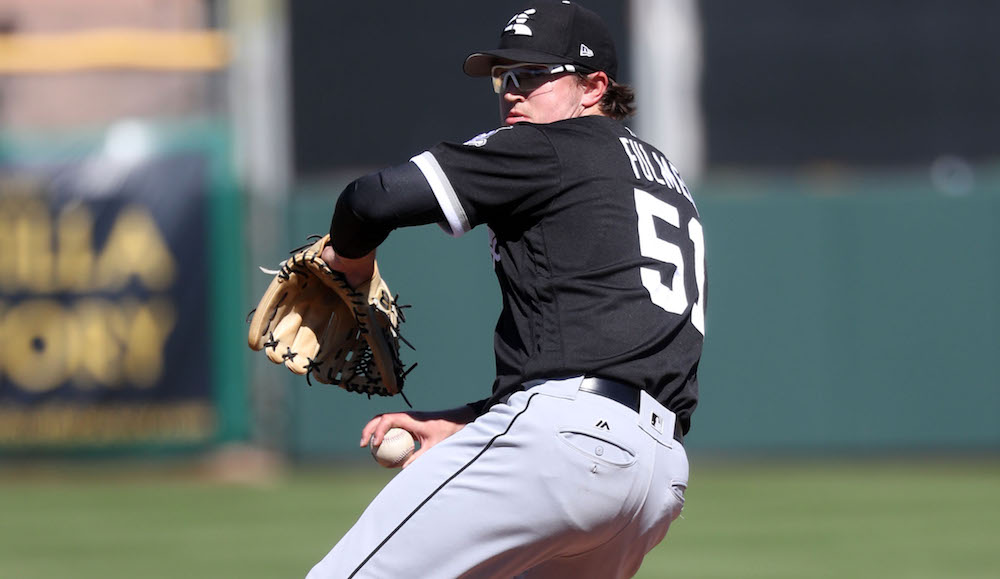Feature photo: Carson Fulmer, RHP, White Sox
I spent a few days back in Pawtucket last week watching the PawSox taking on the Charlotte Knights in a three-game set. Here are my thoughts on six players, including a struggling Carson Fulmer (RHP, White Sox) and the pitchability of Jalen Beeks (LHP, Red Sox). I also wrote up Bryce Brentz (LF/DH, Red Sox), who is crippling International League pitching this year, and I take a look at three other PawSox players who project as role players in the big leagues.
2080 Prospect Spotlights
Triple-A International League
Charlotte Knights (CHW) at Pawtucket Red Sox (BOS)
August 7-9, 2017
 Carson Fulmer, RHP, White Sox (Triple-A Charlotte, International League)
Carson Fulmer, RHP, White Sox (Triple-A Charlotte, International League)
Ht/Wt: 6’0”/195 lbs. B/T: R/R Age (As of April 1, 2017): 23y, 3m
Fulmer has been a prized prospect within the White Sox’ system for the past couple of years, and I was able to get a view of him in his last start August 9 at Pawtucket, where he was roughed up for four earned runs over 5 1/3 innings, giving up four hits and walking four, while striking out seven in a 6-5 loss to the PawSox.
Fulmer is an average athlete with a semi-power arm who was having trouble repeating his herky-jerky delivery in this viewing, and who has had some trouble finding the strike zone over his past six starts, walking 22 batters over his last 34 1/3 innings (5.77 BB/9). He has a short arm action, and there is some violence to the delivery. The speed of his delivery offers some deception but he rushes it, at the expense of his command.
He had average fastball velocity in this viewing, sitting 91-to-94 mph with most readings at 92 mph, and he while he gets some run and tail on the pitch, too many of them were center-cut offerings that were subject to hard contact, and he is in need of more consistent command and movement in the zone to most effective. Both the velo and the movement project as average, and the command is below average presently. His cut fastball was above average, siting in the 87-to-89 mph range with short, quick deceptive action though the movement needs to develop more consistency. The curveball projects as an average offering in the 79-to-81 mph range with 11-to-5 break, and also showed inconsistent shape. The slider was more of a slurve, and looked below average.
The fastball command and the control issues have carried over into 2017, where despite some marginal improvement he is still siting on a well-below-average 4.67 BB/9 rate that is trending the wrong way as the season goes on, and it’s resulting in shorter outings and higher pitch counts. Both the delivery and the arm action seem to fit better in a reliever’s role, where the fastball velocity could play up a tick, and where the command and control profile would become more tolerable. I see Fulmer as a Role 40, sixth- to seventh-inning reliever, with a ceiling of a Role 50 set-up man with the fastball/cutter combination – but it’s all predicated on where the command and control profile ultimately settles.
 Jacob May, CF, White Sox (Triple-A Charlotte, International League)
Jacob May, CF, White Sox (Triple-A Charlotte, International League)
Ht/Wt: 5’10”/180 lbs. B/T: S/R Age (As of April 1, 2017): 25y, 2m
May is switch-hitting center fielder who is a plus athlete, and who brings a below-average hit tool with well below average game power. He has a short, choppy stroke that limits his contact rates on both sides of the ball, though the swing is more serviceable from the left side – where he is hitting .271 versus righties – than it is from the right side, where he is hitting an anaemic .172 in roughly 1/3 of the plate appearances, and where he shows plenty of exploitable holes in his swing. He strikes out more than 24% of the time and his on-base percentage is sitting at a below-average .301 at Charlotte.
May’s strength is his speed, and he is above average out of the box and double-plus once underway. He’s already swiped 23 bases this year, and the speed makes him a double-plus base-stealing threat. The speed also gives him plus range in center field, where he is an overall plus defender. He shows good first-step quickness, and tremendous acceleration into the gaps, and his instincts are good for the position. He does well both coming in on balls, and tracking them back to the wall, and he has enough arm to carry the position, with average arm strength and good carry on his throws.
The hit tool limits the overall profile, though he certainly will bring value to a big league club as a Role 40 OF-5, capable of handling all three outfield positions if needed, and putting pressure on defenses when he does get on base thanks to his speed.
 Jalen Beeks, LHP, Red Sox (Triple-A Pawtucket, International League)
Jalen Beeks, LHP, Red Sox (Triple-A Pawtucket, International League)
Ht/Wt: 5’11”/195 lbs. B/T: L/L Age (As of April 1, 2017): 23y, 8m
Taken in the 12th round of the 2014 draft out of Arkansas, Beek began the year at Double-A Portland, where he made nine starts and pitched 49 1/3 innings to a 2.19 ERA before earning his first promotion to the Triple-A level with PawSox on June 4. His body is fully developed at this point, and the sub-six footer works with a deceptive delivery and arm action. He has a long arm action with a stab in the back, but he showed the ability to repeat well in the six inning start that I viewed, where he allowed just three hits and a run, and struck out six against a single walk.
Beeks has a plus feel for pitching who has an aggressive approach and is a strike-thrower. He’s averaged 9.83 SO/9 for the year between Portland and Pawtucket (up from 7.5 SO/9 across three levels in 2016), with fringe-average control (3.3 BB/9, down from 3.5 last year), though the control has improved over last year (to 3.52 BB/9), and with the repeatable delivery the control should reach average. He showed solid-average fastball velocity, sitting 90-to-93 mph, with most readings at 91 mph with arm-side run and tailing action, and he located it to both sides of the plate with solid-average movement. The command was above average with the fastball he uses the pitch aggressively. He also threw an above-average cutter (88-to-89 mph) with short, quick action that was particularly effective versus righties. His curveball showed downer break in the 73-to-77 mph range, and at the higher velos it was most effective, with depth and occasional two-plane break. The pitch projects to be a fringe-average offering. The changeup was seldom used in this viewing, mostly to righties, and with some fade, and the pitch showed as average.
While Beeks won’t wow you with his size or his stuff, there is enough pitchability in him to see a ceiling of a Role 40 spot-starter or swingman in the major leagues. Travis Wood (LHP, Padres) is the player that comes to mind as a major league comp.
 Tzu-Wei Lin, UTIL, Red Sox (Triple-A Pawtucket, International League)
Tzu-Wei Lin, UTIL, Red Sox (Triple-A Pawtucket, International League)
Ht/Wt: 5’9” 155 lbs. B/T: L/R Age (As of April 1 , 2017): 23y, 1m
Lin was signed as an international free agent in June of 2012 out of Taiwan as a shortstop, but quickly embraced a utility role in the lower minors, moving around from shortstop to second base, third base, and then into a center field role as he advanced through the system. After starting the season at Double-A Portland this year, batting .302 over 48 games, he was promoted directly to the majors on June 24, and he performed well, playing 19 games across the infield (including six starts at shortstop, six at second base and two at third base) and hitting .280 with a pair of triples and a tidy .3y79 on-base percentage. He was optioned back to Pawtucket on July 17th, where he has hit .256 over 19 games.
In my two-game look, I saw him play both second base and center field, and he is being developed to play a utility role up the middle of the field while also playing some third base. He has a compact but athletic body and is fully developed at this point after adding some strength this offseason, and he shows plus athleticism with quick-twitch actions in the field. His swing is short and quick and geared more towards line drives, and this year he looks like he is taking a more aggressive approach at the plate trying to drive the ball into the gaps versus the more flick the bat at pitches with a contact-oriented approach that I’ve seen in the past. With well-below-average power and limited loft and leverage in the swing, he profiles more as a singles- and doubles-type hitter who can manipulate the barrel and fight off pitches that he can’t handle, and overall the hit tool projects as average.
On the bases, Lin is a plus runner underway, and though he gets from first-to-third base well, he’s not going to steal too many bases. He showed solid-average defensive ability in center field with good reads and routes even as he is still relatively new to the position. At second based he looked above average, with quickness, good footwork and agility, and soft hands. His arm is average, and he can throw accurately when on the run, and the arm is serviceable for centerfield but he won’t be throwing too many baserunners out purely on arm strength. He has the look of a Role 45, utility player who value can add some flexibility to a 25-man roster thanks to the hit tool and athleticism to handle multiple positions at an average-or-better level.
 Deven Marrero, INF, Red Sox (Triple-A Pawtucket, International League)
Deven Marrero, INF, Red Sox (Triple-A Pawtucket, International League)
Ht/Wt: 6’1”/194 lbs. B/T: R/R Age (As of April 1, 2017): 26y, 7m
Marrero is a projectable role player at the major league level, with plus defensive instincts and ability that pair with below-average hitting ability and below average game power. A former first-round pick of the Red Sox (#24 overall) out of Arizona State in 2012, Marrero has been up-and-down with Boston on several occasions since 2015, and in his last stint he played a serviceable third base for 38 starts while hitting a pedestrian .212 with three home runs and 23 RBI’s.
Marrero is a streaky hitter who has a compact, line-drive oriented approach and who has quick hands and wrists at the plate. His weakness is staying inside the ball and the swing can appear stiff at times. He’ll cut it off on occasion, and he does strike out a lot (31% in Boston this season, 29% at Pawtucket). There is some loft and leverage in the swing, but it is not over-the-fence power, and the below-average pop he can show at times is mostly to the pull side.
He shows plus athleticism on the defensive side of the ball, with good agility and body control, ad with sure hands and average fielding actions. He also shows good defensive instincts and knows how to play hitters, getting good reds off the bat, and his above-average range is helped by his footwork and first-step quickness. He profiles as a defense-first, light-hitting Role 40 utility player with enough ability to play the middle of the diamond at an average level.
 Bryce Brentz, LF/DH, Red Sox (Triple-A Pawtucket, International League)
Bryce Brentz, LF/DH, Red Sox (Triple-A Pawtucket, International League)
Ht/Wt: 6’0”/210 lbs. B/T: R/R Age (As of April 1, 2017): 28y, 3m
Like Devon Marrero, Brentz is another former Red Sox first-round selection (CRA, #36 overall, 2010 MLB Draft) who has enjoyed a breakout year in Triple-A, being second in the league in home runs (27) and slugging percentage (.546), fourth in RBI’s (76), and fourth in OPS (.890), while being named to the International League All-Star Team, and winning the All-Star Game’s home run derby with 18 bombs in the final round. In my three-game look this past weekend, Brentz went 5-for-11 with three home runs and eight RBI’s.
Brentz has a fully developed, strong and durable frame. He has taken a more aggressive approach at the plate when compared to my prior views of the player, and he’s also incorporated a new toe-tap trigger which has resulted in improved timing and a more consistent swing path – so much so, in fact, that he has hit 21 home runs since he brought the adjustment into game ABs on May 23. The approach is hampered by below-average pitch recognition, and he is prone to swinging at a lot of first pitches as he hunts for fastballs. When he does connect, however, he’s a cripple hitter capable of punishing pitchers’ mistakes, using his quick bat and uppercut-type swing path to generate loft, leverage, and strength in his swing. It gives him double-plus raw power, but the power projects to average game power at the next level because of the overall below average hitting ability. On the bases, he’s a below average runner but he won’t clog the bases.
Defensively, Brentz brings fringe-average ability to left field, and it limits him to that position in the big leagues. The range is below average but playable, and the reads and jumps were suspect in these views, though the arm was average. He should bring some value as a Role 40, part-time role player off the bench, who could see duty in both left field, and as a DH.


